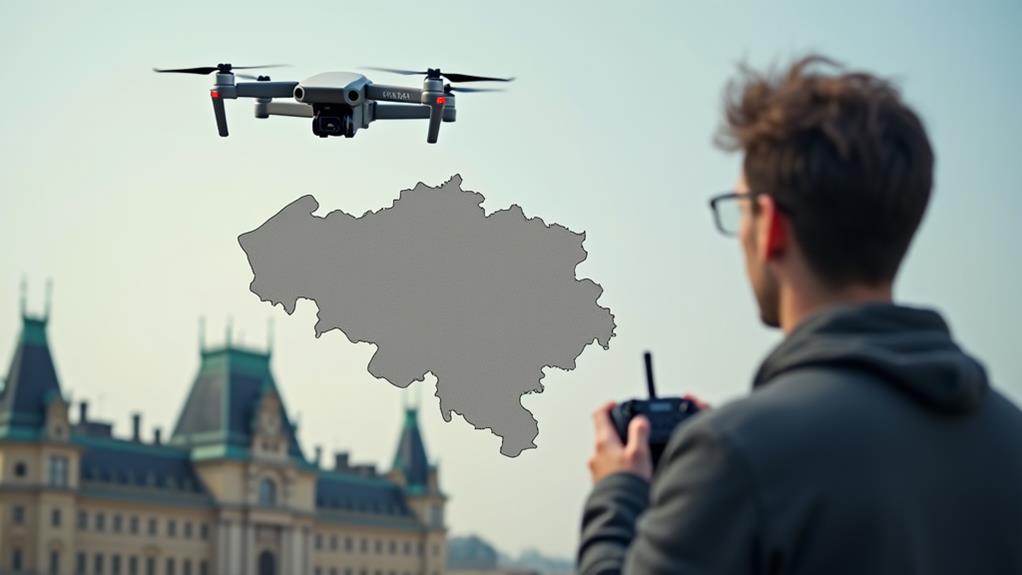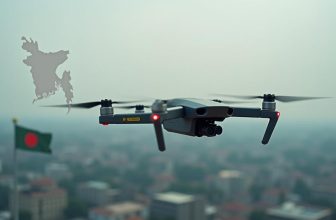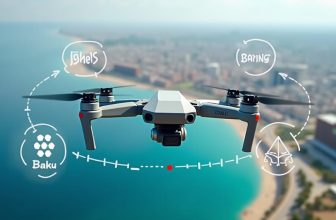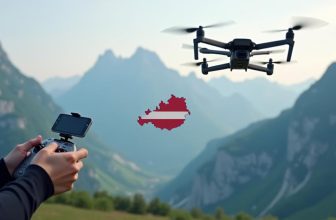
As the saying goes, 'knowledge is power,' and when it comes to flying drones in Belgium, you'll want to be well-informed to avoid any turbulence. With the country's drone laws in place to guarantee safe and responsible operations, you'll need to navigate the regulations carefully. If you're planning to take to the skies with your drone, you're probably wondering what it takes to get started. Do you need to register your drone, and if so, how do you go about it? The answers to these questions, and more, are vital to a smooth flight – but where do you begin?
Contents
Key Takeaways
- Drone registration with the Belgian Civil Aviation Authority (BCAA) is required for drones over 250g and flying above 18 meters.
- Pilot certification requires completing a BCAA-approved training program, demonstrating understanding of regulations and airspace rules.
- Drone pilots must be at least 16 years old, meet medical requirements, and have liability insurance that covers third-party damages.
- The Open Category applies to drones under 25 kg, while Specific and Certified Categories have more stringent standards for complex operations.
- Recreational drone users must comply with BCAA and EASA guidelines, maintaining a safe distance from people and obstacles, and respecting restricted areas.
Drone Registration Requirements
If you plan to operate a drone in Belgium, you'll need to register it first, as the country has specific registration requirements in place.
The registration process is mandatory for drones weighing more than 250 grams and capable of flying above 18 meters. You'll need to create an account on the Belgian Civil Aviation Authority's (BCAA) online registration platform and provide the required information, including your personal data, drone details, and a valid email address.
Registration benefits include increased accountability and safety.
A unique registration number will be assigned to your drone, making it easier to identify and track in case of an incident. Additionally, registration is often a requirement for accessing drone insurance options. Having insurance can provide financial protection in case of accidents or damage to your drone.
Before registering, verify you have the necessary documentation and information.
The BCAA provides detailed guidelines and FAQs on their website to help you through the process. Compliance with the registration requirements is crucial to avoid fines and penalties.
Pilot Certification Process
To become a certified drone pilot in Belgium, you'll first need to meet the eligibility requirements set by the Belgian Civil Aviation Authority (BCAA).
You'll then need to enroll in a training program approved by the BCAA, which will cover topics such as drone operations, safety procedures, and regulations.
Upon completing the training, you can submit a license application to the BCAA, which will evaluate your qualifications and grant you a remote pilot certificate.
Eligibility Requirements
In Belgium, you must be at least 16 years old to apply for a drone pilot certificate. This age restriction applies to all drone pilots, including recreational and commercial operators.
Additionally, you must also meet the medical requirements set by the Belgian Civil Aviation Authority (BCAA). You'll need to undergo a medical examination by an approved medical examiner.
Furthermore, you'll need to have liability insurance that covers damages to third parties. This insurance requirement applies to all drone operations, regardless of the drone's weight or purpose.
The insurance policy must be valid for the entire duration of your drone operations in Belgium.
As a drone pilot, you must also be able to demonstrate a sufficient understanding of the Belgian drone regulations and airspace rules.
This includes understanding the rules for flying in different airspace categories, such as controlled and uncontrolled airspace.
You must also be able to demonstrate your ability to operate a drone safely and responsibly.
Training Programs
Prior to applying for a drone pilot certificate, you must complete a training program approved by the Belgian Civil Aviation Authority (BCAA).
This training is a vital step in the pilot certification process, as it equips you with the necessary knowledge and skills to operate a drone safely and responsibly.
The BCAA has accredited several flight schools to provide drone courses that meet the required standards.
These drone courses cover various topics, including drone regulations, airspace, weather, navigation, and emergency procedures.
You'll also receive hands-on training on drone operations, including pre-flight checks, takeoff and landing procedures, and emergency response techniques.
The training programs are designed to prepare you for the theoretical and practical exams that are part of the pilot certification process.
It is essential to choose a flight school that's approved by the BCAA to guarantee that you receive the required training and meet the certification standards.
License Application
Once you've completed the BCAA-approved training program, it's time to submit your license application as part of the pilot certification process.
You'll need to gather the required documents, which typically include a valid ID, proof of age, and a copy of your training certificate.
Verify that all documents are complete and accurate to avoid any delays in the application process.
You'll need to submit your application within 12 months of completing the training program.
The application timelines may vary depending on the type of license you're applying for, so it's crucial to check with the BCAA for specific requirements.
You'll also need to pay the applicable license fees, which range from €20 to €400, depending on the type of license and the duration of validity.
Once you've submitted your application, the BCAA will review it to confirm that you meet the eligibility criteria.
If your application is approved, you'll receive a pilot license, which is valid for a specific period.
It's your responsibility to confirm that your license is up to date and to renew it before it expires.
Drone Weight Categories
When operating a drone in Belgium, you'll need to understand the different weight categories and their corresponding rules.
The Open Category applies to drones weighing less than 25 kg, and is subject to a set of predefined rules.
If your drone exceeds this weight or requires more complex operations, you'll need to comply with Specific Category requirements or follow Certified Category regulations, which impose more stringent standards.
Open Category Rules
In the Open Category, you'll operate under rules tailored to three distinct drone weight categories. These categories are defined by the drone's maximum take-off mass (MTOM): the A1 subcategory for drones with an MTOM of 250 grams or less, the A2 subcategory for drones with an MTOM of 250 grams to 2 kilograms, and the A3 subcategory for drones with an MTOM of more than 2 kilograms.
When operating in the Open Category, you must adhere to specific requirements.
You'll need to certify that your drone is registered with the Belgian Civil Aviation Authority (BCAA) if it weighs more than 250 grams. In addition, you'll need to obtain airspace authorization prior to flying in controlled airspace. This can be done through the BCAA's online portal.
Consider exploring drone insurance options to mitigate potential risks and liabilities. Always check the weather forecast and air traffic information before flying, and respect the right to privacy of individuals and properties.
Specific Category Requirements
The Open Category provides a framework for drone operations, but specific requirements vary across the three subcategories.
As you prepare to operate your drone in Belgium, verifying the regulations that apply to your specific drone and operation type is crucial.
1. A1 subcategory: Drones with a maximum take-off mass (MTOM) of less than 250g are allowed to fly over people, and you'll need to guarantee your drone meets the requirements for low-risk operations.
You'll also need to obtain Drone Insurance that covers third-party liability.
2. A2 subcategory: Drones with a MTOM of more than 250g but less than 2kg are subject to a 30-meter horizontal distance from people and a 5-meter vertical distance.
You'll need to evaluate the risks associated with your operation and implement mitigation measures, including Drone Security protocols.
3. A3 subcategory: Drones with a MTOM of more than 2kg are subject to stricter regulations, including a minimum distance of 150 meters from people and populated areas.
You'll need to conduct a thorough risk assessment and obtain Drone Insurance that covers higher levels of liability.
Certified Category Regulations
You'll need to design and manufacture your drone according to EU regulations and obtain certification from the European Union Aviation Safety Agency (EASA) or the Belgian Civil Aviation Authority (BCAA).
Additionally, you'll be required to have drone insurance options that cover damages to people and property.
Certified drone operators must undergo training and obtain certification, demonstrating their competence to operate the drone safely.
During operations, you must verify the drone is airworthy, and that maintenance is performed regularly.
Record-keeping is also vital, as you'll need to document maintenance, flight operations, and any incidents.
Moreover, you must comply with BCAA's requirements for pilot training and certification.
Visual Line of Sight
To maintain VLOS, you must adhere to the following guidelines:
1. Maximum Distance: Verify your drone remains within a distance that allows you to see it clearly.
The maximum distance isn't specified, but you must be able to see your drone at all times.
2. Obstacles and Weather Conditions: Be aware of obstacles and weather conditions that may affect your visibility, such as trees, buildings, or fog.
Plan your flight accordingly to maintain VLOS.
3. Assistant or Spotter: Consider having an assistant or spotter to help you guarantee VLOS, especially in complex or high-risk operations.
Airspace Restrictions Map
Maintaining Visual Line of Sight (VLOS) sets the stage for safe drone operations in Belgium.
As you prepare to fly, you'll need to consult the Airspace Restrictions Map to assess potential hazards. This graphical representation of restricted airspace will help you identify areas where drone operations are limited or prohibited.
To accurately interpret the map, you'll need to understand its symbology and color-coding.
Areas with restricted airspace are typically marked with clear boundaries and designations, indicating the type of restriction in place. Your airspace analysis should account for military zones, national parks, and urban areas, as these often have specific regulations governing drone usage.
Map interpretation requires a systematic approach, taking into account the location, altitude, and type of your drone operation.
By carefully evaluating the Airspace Restrictions Map, you can avoid inadvertently violating airspace regulations and guarantee a safe, compliant flight.
This critical step will help you plan your mission and mitigate potential risks associated with restricted airspace.
Always consult the most up-to-date map version to verify accurate information and confirm a successful flight.
Commercial Drone Operations
When establishing your business model, you should consider the following:
- Define your services: Determine the type of commercial drone services you'll offer, such as aerial photography, surveying, or inspection.
- Obtain necessary permits: Verify you have the necessary permits and licenses to operate your commercial drone services in Belgium.
- Develop a safety plan: Create a thorough safety plan that outlines your procedures for guaranteeing safe drone operations.
Having a well-structured business model and following the regulations will help you to successfully operate your commercial drone business in Belgium.
Recreational Drone Rules
Operating a drone for recreational purposes in Belgium comes with its own set of rules and regulations.
As a recreational drone user, you must comply with the guidelines set by the Belgian Civil Aviation Authority (BCAA) and the European Union Aviation Safety Agency (EASA).
When flying for drone recreation or engaging in aerial photography, you're considered an open category operator, subject to specific requirements.
You're not required to register your drone or hold a license, but you must follow basic safety rules.
Verify your drone weighs less than 25 kilograms and stays within your line of sight.
You should also maintain a safe distance from people and obstacles, and respect restricted areas.
Additionally, never fly over or near airports, national parks, or other sensitive areas.
If your drone is equipped with a camera, respect people's privacy and avoid capturing images or footage of individuals without their consent.
Enforcement and Penalties
As you adhere to the recreational drone rules in Belgium, it's equally important to understand the consequences of non-compliance.
The law enforcers in Belgium take drone regulations seriously, and failure to comply can result in severe penalties.
If you're found operating a drone in a prohibited area or violating any other regulations, you may face the following penalties:
- Fines: You may be fined up to €1,500 for violating drone regulations, depending on the severity of the offense.
- Confiscation of the drone: Law enforcers have the authority to confiscate your drone if you're found operating it in a prohibited area or violating any other regulations.
- Revocation of privileges: Repeated offenses may result in the revocation of your privileges to operate a drone in Belgium.
It's essential to familiarize yourself with the fines policies and regulations to avoid any penalties.
The Belgian authorities are strict when it comes to enforcing drone laws, and ignorance isn't an excuse.
If you're unsure about any aspect of drone regulations, it's best to consult the relevant authorities or seek guidance from a qualified expert.
Frequently Asked Questions
Can I Fly a Drone Near a Nuclear Power Plant in Belgium?
You're restricted from flying near a nuclear power plant in Belgium due to stringent power security measures. Plant proximity is heavily regulated to prevent unauthorized access, and drones are no exception, posing a significant security risk.
Are Drone Insurance Policies Mandatory in Belgium?
When operating a drone in Belgium, you're required to have liability insurance, but it's not mandatory to have exhaustive insurance that covers drone damage. You can choose from various drone coverage options to manage insurance premiums.
Can I Fly a Drone in a National Park in Belgium?
You'll need to check the specific park rules before flying a drone in a Belgian national park, as some areas may be restricted for wildlife protection, and permits may be required to guarantee compliance.
How Do I Report a Lost or Stolen Drone in Belgium?
You report a lost or stolen drone in Belgium by contacting the Civil Aviation Authority, providing your drone registration details and last known flight plans, and filing a police report to obtain a theft certificate.
Can I Fly a Drone at Night With Special Permission in Belgium?
You can fly a drone at night in Belgium with special permission, known as an exemption, obtained from the Belgian Civil Aviation Authority, which issues drone permits for night flights under specific conditions.
Conclusion
Navigating Belgium's drone laws can be a complex dance, but with the right steps, you'll be soaring to new heights. By registering your drone, obtaining pilot certification, and understanding weight categories, you'll gain access to a world of aerial possibilities. Remember, compliance is key – stay within the visual line of sight, respect airspace restrictions, and adhere to commercial and recreational rules to avoid penalties. Chart your course wisely and take to the skies with confidence.





